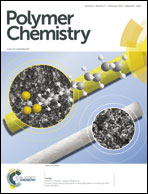Sequence-controlled copolymers of 2,3,4,5-pentafluorostyrene: mechanistic insight and application to organocatalysis†
Abstract
A number of copolymers between styrene (St) or 4-azidomethylstyrene (N3St) and 2,3,4,5,6-pentafluorostyrene (FSt) have been prepared by atom-transfer radical polymerization (ATRP) and conventional free radical polymerization (FRP). The mode of monomer alternation in copolymers has been established unambiguously using heteronuclear multiple bond correlation (HMBC) NMR. The degree and nature of monomer alternation was found to be strongly dependent on both the solvent (or lack thereof) and the polymerization initiator. These results are in contrast to previously published studies, which rely primarily on classic analysis of monomer reactivity ratios. We proceeded to independently functionalize the N3St and FSt moieties using orthogonal “click” chemistries: copper-catalyzed azide–alkyne cycloaddition (CuAAC) and fluoroarene–thiol coupling (FTC). An alternating copolymer bearing –NH2 and –SO3− functional groups was found to be a competent organocatalyst for a Henry reaction between benzaldehyde and nitromethane.


 Please wait while we load your content...
Please wait while we load your content...